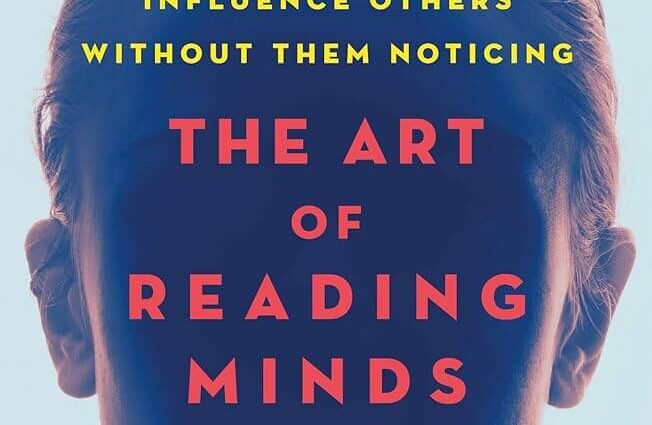📚 Book Details
Name: The Art of Reading Minds: Understand and Influence Others Without Them Noticing
Author: Henrik Fexeus
Page: 288 pages
Language: English
Publisher: St. Martin’s Press
Publishing Date: 18 September 2018
🚀 Book Wrap-Up
The Art of Reading Minds by Henrik Fexeus is a comprehensive guide to understanding and mastering the subtle art of non-verbal communication. This book provides readers with practical tools to decode the unspoken signals people use in their interactions, helping to build stronger personal and professional relationships. Fexeus blends insights from psychology, body language, and communication strategies to offer actionable advice for interpreting and influencing human behavior.
🎨 Should You Read The Art of Reading Minds?
If you’re fascinated by human behavior and want to improve your communication skills, The Art of Reading Minds is an invaluable resource. Here’s why you might consider adding it to your reading list:
- Enhance Communication Skills: Learn to read and interpret non-verbal cues such as facial expressions, body language, and tone of voice.
- Improve Professional Interactions: Gain insights into influencing and negotiating with colleagues and clients effectively.
- Build Empathy: Develop a deeper understanding of others’ emotions and intentions through careful observation.
However, if you’re looking for an academic treatise or a purely theoretical approach to psychology, this book’s practical, action-oriented style might not meet those needs.
📒 My Book Notes of The Art of Reading Minds
I. Introduction to Non-Verbal Communication
Henrik Fexeus starts by introducing the concept of mind reading as a skill rooted in the observation of non-verbal communication rather than any mystical ability. The foundation is understanding how body language and subtle signals provide insight into a person’s true thoughts and feelings.
II. Micro-Expressions: The Hidden Emotions
Fexeus delves into micro-expressions—brief, involuntary facial expressions that reveal true emotions. He explains how to spot these fleeting expressions to uncover hidden feelings such as joy, surprise, or discomfort. Practical tips include focusing on facial muscles and the speed of expression changes to accurately interpret emotions.
III. The Language of Body Movements
The book explores how various body movements and postures convey specific messages. For instance, crossed arms might indicate defensiveness, while open gestures suggest openness and confidence. Fexeus provides methods to read these signals and understand their implications in different contexts.
IV. Decoding Eye Behavior
Eye movements and gaze patterns are crucial in understanding non-verbal communication. Fexeus details how eye contact, blink rate, and pupil dilation can reveal a person’s level of interest, honesty, or discomfort. Techniques for analyzing eye behavior help readers gauge others’ emotional states and intentions.
V. Understanding Tone and Speech Patterns
Beyond physical cues, Fexeus emphasizes the importance of tone of voice and speech patterns. He explains how variations in pitch, volume, and speed can indicate stress, excitement, or deceit. Practical exercises include listening for these cues in conversations to better understand underlying emotions and intentions.
VI. Building Rapport Through Mirroring
Mirroring is a technique where you subtly imitate the body language of others to build rapport. Fexeus describes how mirroring can create a sense of connection and trust, making interactions smoother. Tips include adjusting your mirroring to suit the context and the individual you are interacting with.
VII. Advanced Psychological Techniques for Influence
Fexeus presents advanced strategies for influencing others based on their non-verbal cues. This includes the use of persuasive language, strategic pauses, and the power of suggestion. The goal is to guide conversations and negotiations in a way that aligns with your objectives while maintaining ethical standards.
VIII. The Science Behind Mind Reading
The book explores the scientific research underpinning the techniques discussed. Fexeus examines studies on body language, psychological theories, and neurological research to provide a solid grounding for the methods presented. This section offers a deeper understanding of why these techniques are effective.
IX. Common Pitfalls and How to Avoid Them
Fexeus addresses common errors in interpreting non-verbal signals, such as cultural differences and personal biases. He provides strategies for overcoming these pitfalls to ensure more accurate readings of others’ behaviors and emotions. This includes being aware of your own biases and the context of interactions.
X. Practical Exercises and Applications
The book is filled with practical exercises designed to help readers apply the concepts in real-life situations. Exercises include observing interactions in public spaces, practicing responses based on non-verbal cues, and role-playing scenarios to enhance your skills. These exercises are aimed at making the theoretical knowledge actionable.
XI. Building Emotional Intelligence Through Observation
Fexeus highlights the importance of emotional intelligence in reading minds. He provides strategies for developing empathy and improving interpersonal skills through careful observation and reflection. Techniques include journaling about interactions and seeking feedback from others.
XII. Real-Life Case Studies
The book includes case studies that illustrate how the principles of mind reading have been successfully applied in various scenarios. These real-life examples provide insight into the practical benefits of mastering non-verbal communication, from improving relationships to enhancing professional success.
XIII. Ethical Considerations
Fexeus discusses the ethical implications of using mind-reading techniques. He emphasizes the importance of using these skills responsibly and with respect for others’ privacy. Guidelines are provided for applying these techniques in a way that fosters positive interactions and avoids manipulation.
🔭 Review of The Art of Reading Minds
The Art of Reading Minds by Henrik Fexeus is an engaging and practical guide to mastering the subtleties of human communication. The book’s strength lies in its actionable advice and exercises, making complex concepts accessible to a wide audience.
On the Positive Side:
Fexeus’s practical approach and clear writing style make this book an easy read. The exercises and real-life applications ensure that readers can immediately implement the techniques in their daily lives. The scientific basis and ethical considerations add depth to the practical advice.
On the Flip Side:
Some readers might find the book’s focus on application over theory limiting if they are looking for a more academic exploration of non-verbal communication. Additionally, the ethical implications of influence techniques may raise concerns if not approached with care.
Overall, The Art of Reading Minds is a valuable resource for anyone looking to enhance their communication skills and gain a deeper understanding of others. Its practical nature makes it suitable for both personal and professional development.
💯 My Rating
🌕🌕🌕🌕🌑

